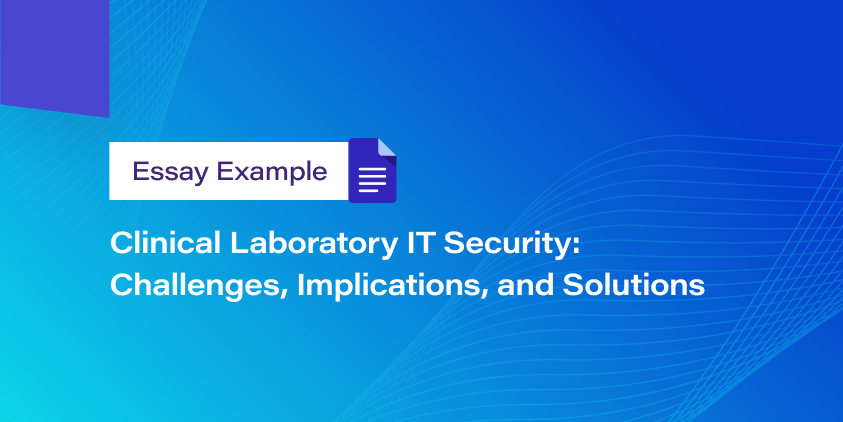Clinical Laboratory IT Security: Challenges, Implications, and Solutions

The invention of computers has enabled efficient and effective management of clients. But security issues have been a major concern to both software applications and their stored data. Clinical laboratory departments in hospitals are no exceptions; they store patients’ health records such as name, kind of diseases diagnosed, medicine prescribed, frequency of reception and drug reactions, etc.
Since patients who visit many health facilities may have multiple health records, the need arose for a shared system that all clinicians can access. This led to the development of centralized medical records that all stakeholders can access over the Internet.
Challenges to Clinical Laboratory IT Security
Data or information in clinical laboratory systems are always very sensitive and require secure environments. This is normally not the case in many laboratory systems. The systems are accessible by physicians, nurses, laboratory workers, patients, patients’ relatives, information technology support, IT service providers and firms that maintain them. Since they can be accessed by many people who need the data, securing the records becomes a challenge. Threats to clinical information are grouped into human, natural, environmental and technological factors.
Human factors are threats imposed by human beings. They include hacking, stealing of passwords, eavesdropping, interception and physical damage. Hacking involves trying all means to compromise a system. It includes trying many letters to guess passwords to gain permission to access systems and steal information. Though some hackers may not interfere with systems, their access to the system has far-reaching implications for clinical laboratories. They can also steal passwords while users enter them. This permits them to enter the clinical laboratory system.
In certain cases, people can secretly listen to the private communication of clinical workers. This commonly occurs while communication occurs over the Internet and can be done in person or using specialized software. The message content reaches the destination unaltered in eavesdropping, but the eavesdropper remains with a copy of the entire information. A human can also intercept information traveling over the network. In such a case, the information does not reach the intended destination but remains with the interceptor.
Human physical actions always challenge information technology infrastructure. They include physical shooting, flooding of computers, and passing electromagnetic substances over computer storage devices. Physical shooting and flooding of computers destroy both hardware and software, while electromagnetic material destroys information stored in computer storage devices.
Technologically malicious computer software, such as viruses, Trojans and worms, can greatly affect data or information stored in the clinical laboratory system. The effects of their actions range from slowing down computer systems to permanently deleting stored information.
Implications of Security Breaches of Health Care Data
Security breaches of healthcare data implicate medical professionals, patients, patient’s relatives and information technology professionals. Medical professionals might lose their sensitive professional as well as patients’ data. This will greatly affect the results of their long-time studies and research. Patients may also lose their medical records, which may harm their health and finances if not resolved in time. They may have to wait longer for the data to be recovered at the expense of their health or spend extra money for new tests and treatments. Relatives of patients can also be affected by the breach of security in clinical laboratory services. If the patients’ data are lost, they may have to spend more money and time on new tests and treatments and bear the psychological effects of the patient’s conditions for longer. Information technology professionals are not excluded, as they will have to spend hours and days recovering lost data and developing security measures to ensure that infrastructure is secure.
Security Measures
Clinical laboratory staff and other stakeholders accessing the system should get assigned permissions by information technology administrators. This involves issuing them unique logins and passwords and periodically changing them to ensure maximum security. Providing logins and passwords might not affect the users, but their periodic changes might be problematic. They will have to periodically master logins and passwords, which they might easily forget.
To prevent eavesdropping and interception, more secure algorithms should be utilized to encrypt data before they are sent and provide acknowledgments between sender and receiver during communication. Since such algorithms are implemented in software, users may need help to easily use them, and it may take a long time to learn how they are used.
Securing the information technology room using locks, security personnel, or electrical fences and doors prevents unauthorized persons from accessing the computer area and physically interfering with them. In this case, users might need help since they must undergo searches before entering their work areas. In the case of electrical fences, users will have to be provided with electronic cards to open the fences and access the areas. This might be a problem for users as they might need to remember them at home or lose them.
Appropriate Balance
Data security ensures information technology infrastructure is safe, but security measures should not hinder users from accessing them. While designing security measures, it is prudent to ensure that users can easily use the measures to access their systems without any difficulties. The measures should only prevent intruders, not users, from accessing systems.
Conclusion
Clinical laboratory data are important to patients, their relatives, medical professionals and information technology experts. Appropriate security measures should therefore be put in place to ensure their safety. The measure taken, however, should be fine with the ease of use of the computer systems.
